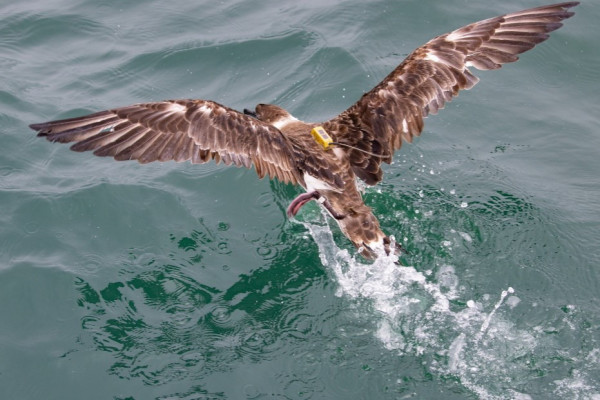
A Great Shearwater takes off with its satellite “backpack” tag visible on its back. The solar powered tag weighs 15 grams and provides 15 – 20 locations per day for many months. Courtesy image.
By Dr. David Wiley
The waters around Cape Cod are home to many types of birds that most non-fishing people will never see. Known as “pelagics,” they spend their entire lives at sea, returning to land only to nest and raise their young.
One of the most numerous is the Great Shearwater, a brown-and-white bird with a four-foot wingspan, often seen gliding a few feet above the waves in search of food.
There is more to Great Shearwaters than meets even the trained eye of a fisherman. Since 2013, our team of scientists from the Stellwagen Bank National Marine Sanctuary have been learning about these birds by attaching small transmitter tags to them. These tags send signals to orbiting satellites, which then calculate locations several times per day and allow us to track and map their movements. To attach the tags, we capture birds by baiting them close to our research vessel and scooping them with long-handled nets. We thank Ray Kane of the Fishermen’s Alliance for accompanying us, providing expert advice on chumming, and offering insights into the birds’ behavior around fishing boats.
Great Shearwaters are constant travelers, moving around the northern and southern hemispheres as the summer season also migrates. These birds of endless summer arrive at Cape Cod and the Gulf of Manie in May and June, and leave now, sometime between September and November.
Adults leave first, headed for breeding colonies on the South Atlantic’s Tristan da Cunha islands. Located halfway between the tips of South America and Africa, these islands are considered one of the most remote places on earth.
To get there, shearwaters fly east towards Spain and then down the coast of North Africa. Just north of the equator they re-cross the Atlantic to the coast of Brazil or the Tristen Islands. Our tag data tell us they fly nearly 10,000 miles in 28 to 35 days, reaching speeds of more than 30 miles per hour.
Once adults reach the breeding colony, they somehow meet their life-long partner around the entrance to their underground nesting burrow and lay a single, white egg. The parents then take 30-day turns alternating between incubating the egg and making feeding flights to the Patagonia shelf off of Argentina or areas off South Africa, round trip distances of almost 9,000 miles. In April they head back north, this time taking a more easterly route along the coasts of South and North America.
How they navigate over the seemingly trackless expanse of ocean remains one of the biggest unanswered questions in biology. We hope our tracking data will someday solve the mystery.
While Great Shearwater migration and navigation is intriguing, the main focus of our research is how the birds use the Stellwagen Sanctuary and the Gulf of Maine. By mapping movements of 58 satellite-tracked birds from 2013 to 2019, we found that an area stretching from Stellwagen Bank south to the Great South Channel east of Cape Cod and then north through Georges Bank is most important.
The common factor is sand habitat favorable for supporting sand eel (sand lance) forage fish. The importance of eating sand eels was confirmed by analyzing the DNA in fecal samples taken from captured birds, with sand eel DNA most frequently found.
Sand eels are captured one at a time with shallow dives below the surface; Great Shearwaters can dive as deep as 50 feet, but most dives are within six feet. To move underwater, they use their wings as oars to chase fish or occasionally snag scraps from fishing boats.
Our research has also discovered that the vast majority of Great Shearwaters around the Cape and in the Gulf of Maine are juveniles. While we know little about their lifespan, similar species can live as long as 50 years and do not breed until around 7 years of age.
This summer, we tagged another 10 Great Shearwaters in the waters east of Chatham. If you’re intrigued with their travels, these birds can now be followed @Trackseabirds or on the Stellwagen Sanctuary’s website https://sanctuaries.noaa.gov/news/nov16/birds-indicators-ecosystem-health.html Teachers can also use our data in a series of lesson plans highlighting shearwaters, including poster-size, laminated charts that can be used for plotting bird movements using real data from our research.
With this remarkable technology, the lives of birds that have always been there but are almost never seen have now become much more accessible.
(David Wiley is the Research Ecologist for NOAA’s Stellwagen Bank National Marine Sanctuary)
